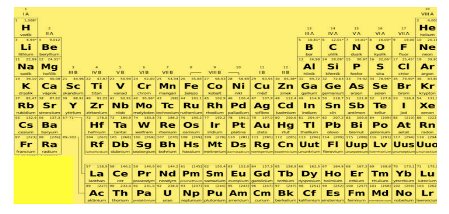
The type of elements present in group 3 to 12[IB to VIIB and VIII] are:
A. Alkali
B. Alkaline
C. Transition
D. halogen
Answer
122.1k+ views
Hint: According to the recommendation of International Union of Pure and Applied Chemistry (IUPAC), the groups are numbered from 1 to 18 replacing the older notation of groups IA… VIIA, VIII, 1B and 0. This is called a long form of periodic table.
Complete step-by-step answer:
Elements in the same column of the periodic table have the same number of valence electrons in their outer energy level. This leads to their similar properties. All the elements in group 1(IA) have just one valence electron and therefore they are highly reactive. All the other elements in group 1 except hydrogen are alkali metals.
The alkaline earth metals include all the elements in group 2(IIA). These have just two valence electrons, they are reactive but less than alkali metals. Groups 3-12(IB to VIIB and VIII) of the periodic table contain transition metals. They have more valence electrons and are less reactive than the first two groups.
Groups 13-16 each contain one or more metalloids, group 13(IIIA) is boron group(boron is a metalloid). Group 14(IVA) is carbon group, group 15(VA) is nitrogen group and group 16(VIA) is oxygen group. These groups have nonmetals and metalloids as their elements.
Elements in group 17(VIIA) belong to the halogen family. They are very reactive non-metals with seven electrons in their valence shell. Group 18(VIIIA) elements are also non-metals and called noble gases. Their outer energy level is full, hence they are very stable and least reactive.

Hence, the correct option is (C).
Note: This modern periodic table states that the physical and chemical properties of the elements are periodic functions of their atomic numbers. But as per old periodic table by Mendeleev, it was a periodic function of atomic masses. It was rejected because he was not able to locate hydrogen and isotopes of elements which were found later on.
Complete step-by-step answer:
Elements in the same column of the periodic table have the same number of valence electrons in their outer energy level. This leads to their similar properties. All the elements in group 1(IA) have just one valence electron and therefore they are highly reactive. All the other elements in group 1 except hydrogen are alkali metals.
The alkaline earth metals include all the elements in group 2(IIA). These have just two valence electrons, they are reactive but less than alkali metals. Groups 3-12(IB to VIIB and VIII) of the periodic table contain transition metals. They have more valence electrons and are less reactive than the first two groups.
Groups 13-16 each contain one or more metalloids, group 13(IIIA) is boron group(boron is a metalloid). Group 14(IVA) is carbon group, group 15(VA) is nitrogen group and group 16(VIA) is oxygen group. These groups have nonmetals and metalloids as their elements.
Elements in group 17(VIIA) belong to the halogen family. They are very reactive non-metals with seven electrons in their valence shell. Group 18(VIIIA) elements are also non-metals and called noble gases. Their outer energy level is full, hence they are very stable and least reactive.

Hence, the correct option is (C).
Note: This modern periodic table states that the physical and chemical properties of the elements are periodic functions of their atomic numbers. But as per old periodic table by Mendeleev, it was a periodic function of atomic masses. It was rejected because he was not able to locate hydrogen and isotopes of elements which were found later on.
Recently Updated Pages
The colour of ammonium phosphomolybdate is A Green class 11 chemistry JEE_Main

The oxidation number of chlorine in HOCl is A 1 B zero class 11 chemistry JEE_Main

The degree of hydrolysis of salt of a weak acid and class 11 chemistry JEE_Main

The maximum covalency of nitrogen is A 3 B 4 C 5 D class 11 chemistry JEE_Main

Reaction of PdBaSO4 with 2butyne gives predominantly class 11 chemistry JEE_Main

Aromatization of nhexane gives A Benzene B Toluene class 11 chemistry JEE_Main

Trending doubts
JEE Mains 2025: Check Important Dates, Syllabus, Exam Pattern, Fee and Updates

JEE Main Login 2045: Step-by-Step Instructions and Details

JEE Main Chemistry Question Paper with Answer Keys and Solutions

JEE Main Exam Marking Scheme: Detailed Breakdown of Marks and Negative Marking

JEE Main 2023 January 24 Shift 2 Question Paper with Answer Keys & Solutions

JEE Main Chemistry Exam Pattern 2025

Other Pages
NCERT Solutions for Class 11 Chemistry Chapter 7 Redox Reaction

NCERT Solutions for Class 11 Chemistry Chapter 5 Thermodynamics

NCERT Solutions for Class 11 Chemistry Chapter 8 Organic Chemistry

NCERT Solutions for Class 11 Chemistry Chapter 6 Equilibrium

NCERT Solutions for Class 11 Chemistry Chapter 9 Hydrocarbons

JEE Advanced Marks vs Ranks 2025: Understanding Category-wise Qualifying Marks and Previous Year Cut-offs




